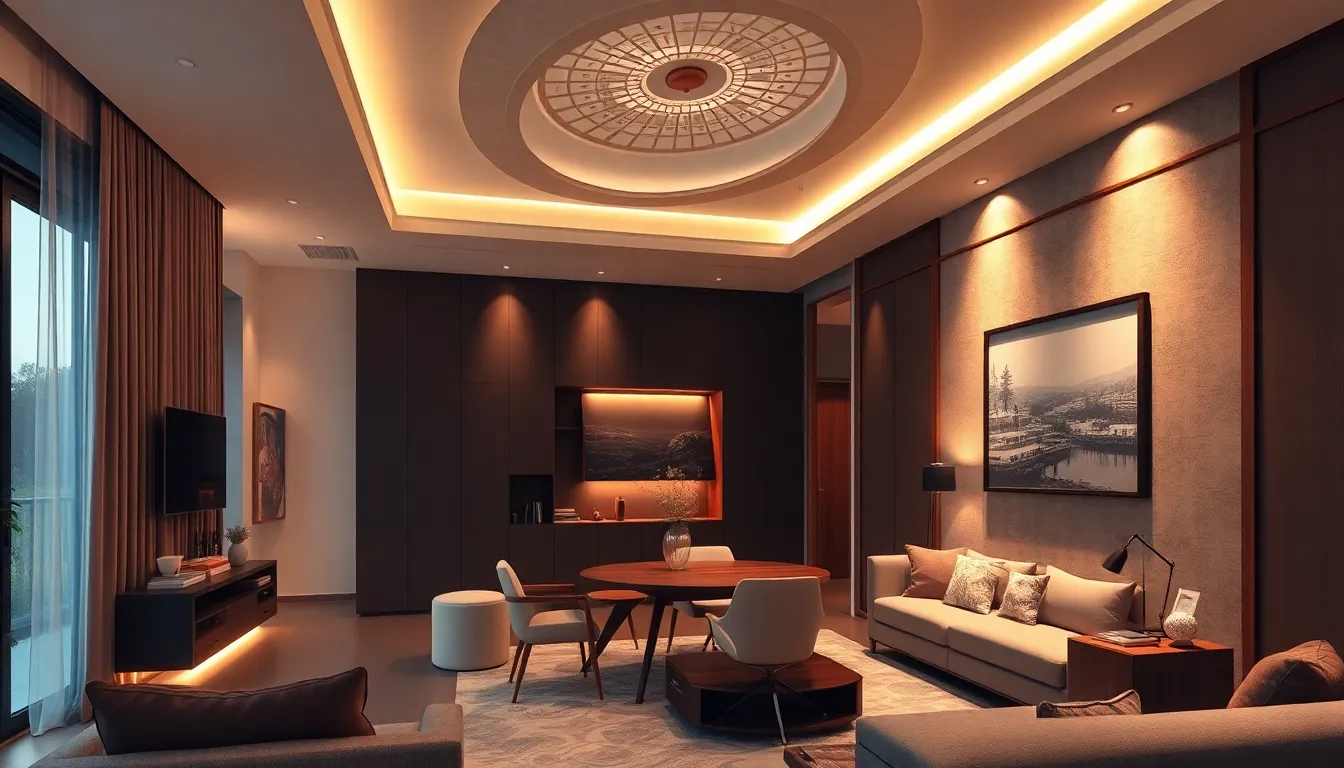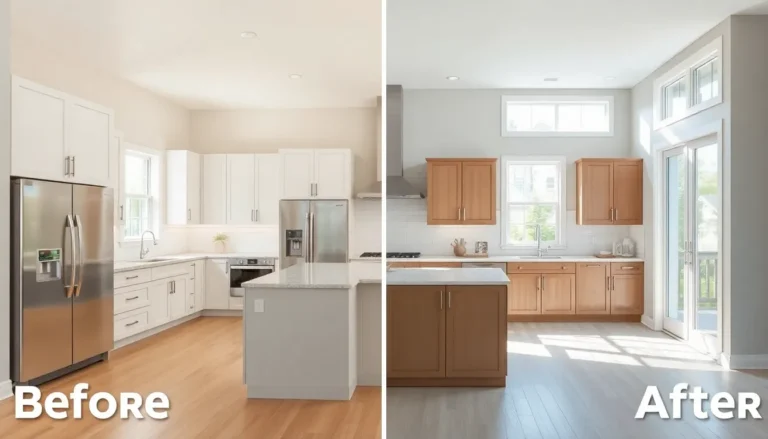Table of Contents
ToggleLighting design plays a crucial role in shaping the atmosphere and functionality of any space. From cozy homes to bustling commercial environments, the right lighting can transform an ordinary room into an inviting sanctuary or a dynamic workspace. It’s not just about illumination; it’s about creating mood, highlighting features, and enhancing the overall aesthetic.
With advancements in technology and a growing awareness of energy efficiency, the landscape of lighting design is evolving. Designers now have access to a wide array of fixtures, smart systems, and sustainable options that not only elevate visual appeal but also reduce environmental impact. Understanding the principles of lighting design can empower anyone to make informed choices that enhance their living or working spaces.
Overview of Lighting Design
Lighting design plays a crucial role in enhancing the functionality and aesthetics of any space. It involves the skillful arrangement of light sources to achieve specific effects, emphasizing architectural features and creating an appealing ambiance.
Key principles of lighting design include:
- Layering: Combining ambient, task, and accent lighting to create depth and dimension.
- Color Temperature: Selecting warm or cool light tones influences mood and perception in an area.
- Control Systems: Utilizing dimmers and smart lighting solutions enables customization of brightness and atmosphere.
Advancements in technology have significantly shaped modern lighting design. Energy-efficient solutions, such as LED fixtures, consume less power and offer a longer lifespan, making them eco-friendly options. Smart systems allow remote control and automation, contributing to both convenience and energy savings.
Understanding these key elements empowers individuals to create well-lit environments that meet their needs while maintaining visual interest.
Importance of Lighting Design

Lighting design plays a crucial role in enhancing both aesthetics and functionality in various spaces. Properly designed lighting elevates environments, supporting their intended use while creating visual interest.
Enhancing Aesthetic Appeal
Effective lighting design enhances aesthetic appeal by highlighting architectural features and creating mood. Ambient lighting provides a base layer that fills a space with light. Accent lighting draws attention to specific artwork or design elements, enriching the visual experience. Task lighting illuminates work areas, ensuring both beauty and practicality. By selecting the right color temperatures, designers can evoke specific emotions; warm tones create a cozy atmosphere, while cooler tones promote alertness. Furthermore, incorporating different intensity levels fosters versatility, allowing spaces to transition seamlessly from day to night.
Improving Functionality
Lighting design improves functionality by ensuring spaces are appropriately illuminated for their intended purposes. Layering various light types creates zones for different activities, maximizing usability. In work areas, task lighting reduces eye strain by providing focused illumination. In relaxation areas, ambient lighting facilitates comfort and relaxation. Control systems, such as dimmers and smart technology, allow users to adjust brightness according to changing needs. Additionally, energy-efficient options, like LED fixtures, deliver effective solutions that enhance visibility while minimizing costs. Understanding these functional aspects helps individuals create adaptable environments that truly serve their requirements.
Key Principles of Lighting Design
Key principles of lighting design focus on creating cohesive and functional spaces. By applying these principles, individuals can achieve balanced and aesthetically pleasing environments.
Balance and Harmony
Balance and harmony in lighting design ensure a unified appearance across a space. Achieving this involves distributing light evenly to avoid overly bright or dark areas. Consider these aspects:
- Light Distribution: Utilize fixtures of varying intensities to create a uniform spread, preventing visual clutter.
- Visual Weight: Place strong light sources to counterbalance darker areas, contributing to a well-rounded design.
- Color Consistency: Use similar color temperatures across fixtures to maintain a harmonious visual flow, creating a cohesive atmosphere.
Layered Lighting Techniques
Layered lighting techniques enhance depth and functionality in a design. Implementing different lighting types offers versatility and meets specific needs. The key types include:
- Ambient Lighting: Serve as the foundation for illumination, filling spaces with general light from fixtures such as ceiling lights or chandeliers.
- Task Lighting: Offer focused light for specific activities, improving visibility over work surfaces with fixtures like desk lamps or under-cabinet lights.
- Accent Lighting: Highlight architectural features or artwork, utilizing spotlights or wall-mounted fixtures for added visual interest.
Combining these lighting types creates an inviting and adaptable environment, allowing users to adjust according to various activities and moods.
Styles of Lighting Design
Lighting design showcases various styles that cater to different aesthetics and functionalities. Each style contributes uniquely to the ambiance of a space, whether modern or traditional.
Modern Lighting Design
Modern lighting design emphasizes sleek lines, minimalism, and innovative technology. Designers often prioritize functionality while integrating artistic elements. Key characteristics include:
- Geometric Shapes: Fixtures utilize simple forms like cylinders and squares, enhancing contemporary aesthetics.
- LED Technology: Energy-efficient LED lighting offers versatility, allowing for dynamic color changes and effects.
- Integrated Solutions: Built-in lighting in architecture, such as recessed fixtures, provides seamless illumination, creating clean sightlines.
- Smart Controls: Smart technology, including dimmers and automation systems, allows for customizable lighting scenarios that adapt to user preferences.
Modern lighting creates a bright, airy atmosphere, perfect for open spaces and contemporary decor.
Traditional Lighting Design
Traditional lighting design reflects historical styles and classical craftsmanship, providing warmth and character. This style features:
- Chandeliers: Ornate fixtures often serve as focal points, combining elegance with functional lighting in dining areas and entryways.
- Candles and Lanterns: These fixtures evoke a sense of nostalgia, enhancing vintage or rustic themes.
- Classic Materials: Designs incorporate wood, metal, and glass, each chosen for their timeless appeal and durability.
- Warm Color Temperatures: Soft, warm light fosters a cozy atmosphere, making spaces feel inviting and comforting.
Traditional lighting infuses spaces with a sense of history, complementing ornate furnishings and architectural details.
Challenges in Lighting Design
Lighting design faces various challenges that can impact the overall effectiveness and appeal of a space. Two significant obstacles include budget constraints and space limitations.
Budget Constraints
Budget constraints often hinder the ability to achieve optimal lighting design. Affordable choices may prioritize functionality over aesthetics, limiting creative options. Ultimately, this constraint can result in a reliance on cost-effective fixtures, which might not deliver desired illumination quality or energy efficiency. Designers often navigate these limitations by selecting strategically impactful elements, such as key feature lighting or energy-efficient options, that maximize visual impact without exceeding financial boundaries.
Space Limitations
Space limitations present a unique challenge in lighting design. Restricted areas make it difficult to implement layered lighting techniques or incorporate large fixtures. In these scenarios, designers often focus on maximizing light distribution through compact or adjustable fixtures. Using wall-mounted sconces or recessed lighting enables effective illumination while maintaining a clean aesthetic. Additionally, these approaches help create the illusion of a more spacious environment, enhancing functionality and comfort in confined settings.
Lighting design plays a crucial role in shaping the overall experience of any space. By thoughtfully combining different lighting types and styles, individuals can create environments that are not only functional but also visually captivating. The right balance of ambient, task, and accent lighting enhances aesthetics while ensuring practicality.
As technology continues to evolve, incorporating smart solutions and energy-efficient options becomes increasingly accessible. This allows for greater flexibility and customization in lighting design. Ultimately, understanding the principles of lighting can empower anyone to transform their spaces into harmonious and inviting environments that reflect personal style and meet specific needs.





